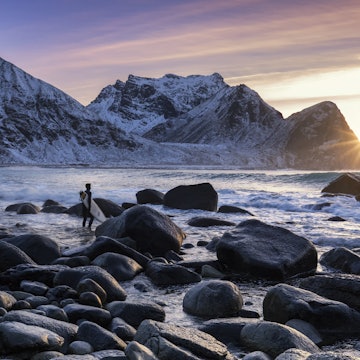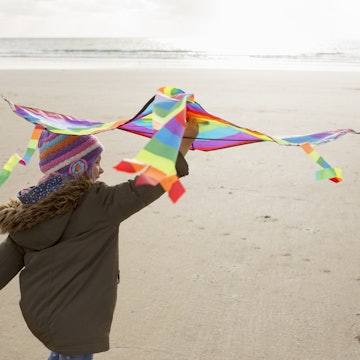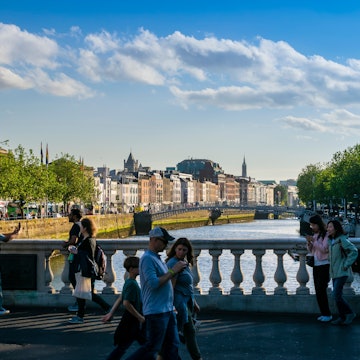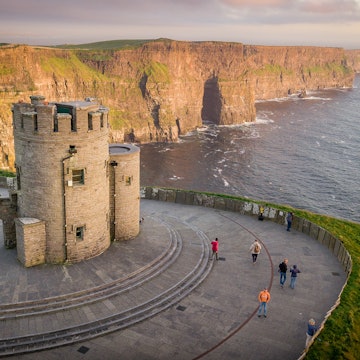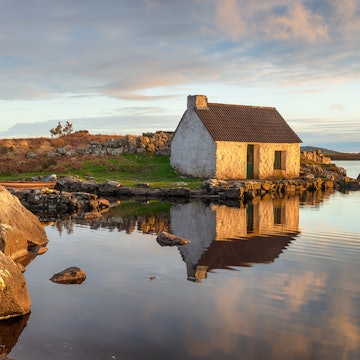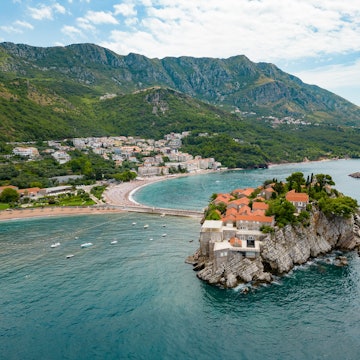
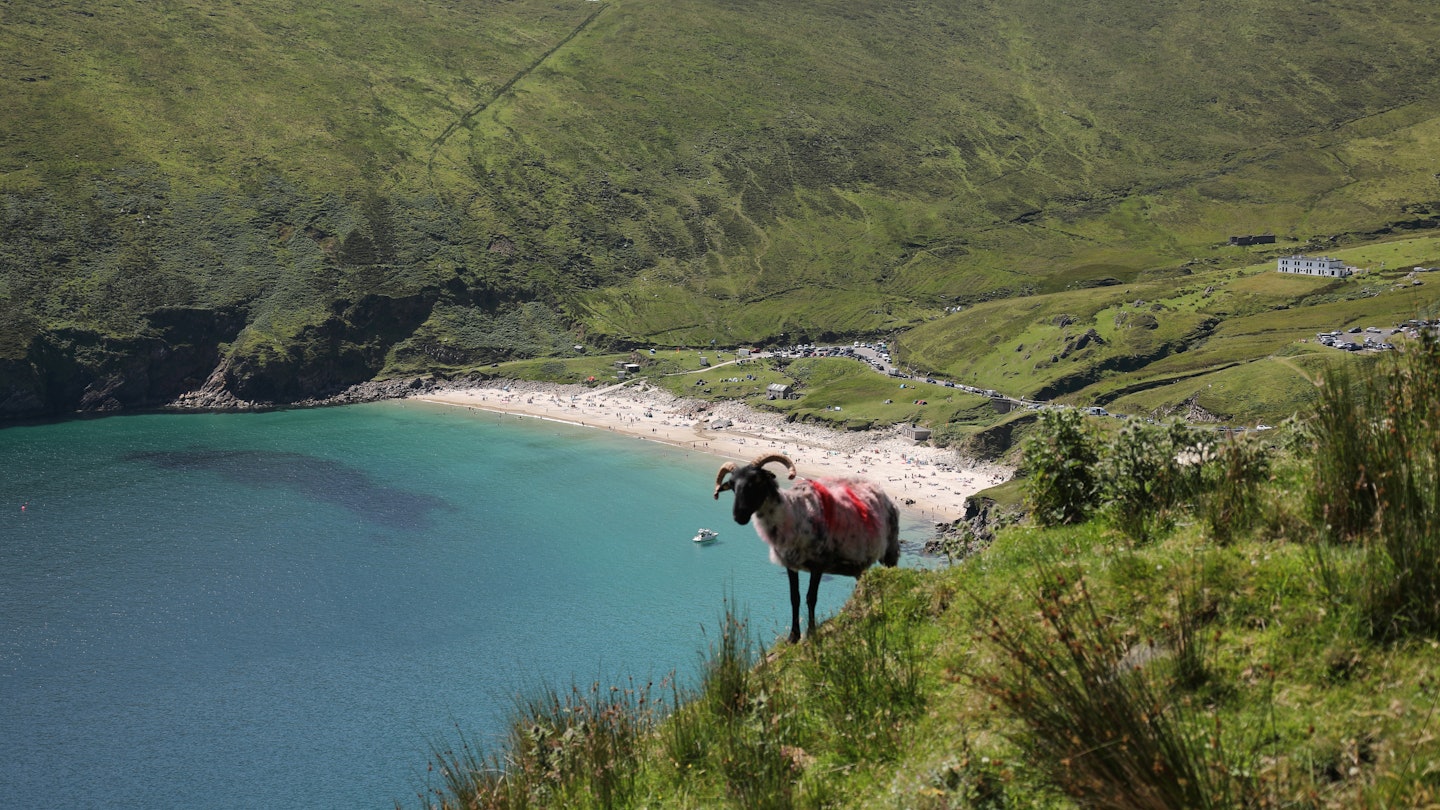
Sheep overlooking Keem Bay, Achill Island © Chaosheng Zhang
There are few places in the world that can match the beauty of Ireland’s islands. Even on wet, misty days, the islands are compelling. Their rugged features become more dramatic. They inspire stories – and adventures. Hundreds of islands dot the coastline of Ireland, each offering something special. From wild tales of pirate queens and one-eyed warrior kings to surprising appearances of wild wallabies or a tropical lagoon in Irish waters, the islands offer a uniquely Irish experience.

1. Achill Island, County Mayo
Best for cinematic landscapes, outdoor adventures and basking sharks
Along with the Aran island of Inis Mór, Achill was the location for the fictional island of Inisherin in the Oscar-nominated The Banshees of Inisherin. Director Martin McDonagh wanted to capture the beauty of Ireland’s western islands on screen with the island becoming another protagonist in the film. Home to towering sea cliffs, soaring mountains, sheltered bays and secret beaches, the scenery is striking indeed.
But the island isn’t just getting by on its looks. The second most populous island in Ireland after the Great Island in County Cork, there are plenty of things to do like hiking, cycling, rock climbing and canoeing. It’s also a great spot for surfing – particularly along the wind-bashed Dooagh Strand – and swimming at the island’s many Blue Flag beaches. Start your day with a morning swim in Keem Bay, a white-sand beach that occasionally attracts basking sharks. Hike the Cliffs of Croaghaun or learn more about the island’s history from local guides on the Colony Tour or the Deserted Village Tour.
Get there: The island is connected by a bridge and makes for an easy day trip from mainland Mayo. You can also bike on the Great Western Greenway, a 26-mile trail that starts in Westport. Westport Bike Hire organizes twice-daily shuttles between Westport and Achill if you don't have your own wheels.

2. Tory Island, County Donegal
Best for sea dives, mythology and kings
Tory Island is the most remote of the Irish islands. With a population of roughly 140 people, just one hotel and a handful of B&Bs, the buzz of city life fades away quickly here, with the feeling of bygone days taking its place. As part of Donegal’s Gaeltacht region, Irish is the first language here, but English is also spoken.
Tory is a swimmer’s and diver’s dream. Take a dip at the harbor or book a diving session with Mevagh Dive Centre to investigate the wreck of the HMS Wasp, a Royal Navy gunboat whose crew was en route to evict poor tenant families in 1884. It’s said that the island’s Neolithic cursing stone, Cloch na Mallacht, was used to steer the ship off course and toward its untimely end.
Tory Island is rich in folklore, with Balor, the one-eyed warrior king of the mythological Irish superrace, the Fomorians, ruling there. On the east coast of the island, the ruins of his fort (Dún Balor) look out across the sea. From here, you can see An Eochair Mhór (the big key), a long spur that juts out from a peninsula, forming An Tor Mór (the big rock), where Balor imprisoned his daughter. The locals also have a longstanding tradition of choosing a king to represent them; but the last King of Tory passed away in October 2018.
Get there: Ferries for Tory Island depart daily from Magheraroarty Pier, County Donegal. The journey takes roughly 45 minutes and you can book tickets online.

3. Inis Meáin, County Galway
Best for Irish literary history and scenic seascapes
With 200 people living on the island, Inis Meáin (Inishmaan) has the smallest population of the three Aran Islands. Since the community is predominantly Irish-speaking, you can immerse yourself in traditional culture while getting back to nature. While it’s the least visited of the Aran Islands, it offers plenty to do, including beach swims, scenic diving spots, ancient ruins and traditional music sessions in the Teach Ósta pub.
The island is small, so you can take in the sights on foot, stopping off to admire wildflowers or swimming by the old port. But if you really want to get to know the island, rent a bike.
Close to the prehistoric stone fort of Dún Chonchúir is the holiday cottage of the playwright JM Synge, who is said to have drawn inspiration for The Playboy of the Western World here. The 300-year-old Teach Synge cottage is now open to the public as a library and a museum. Synge’s chair was a writing spot the author cherished, thanks to its views that overlook the island’s “puffing holes,” where sea water rushes in through a series of natural channels in the cliffs to create a spray.
Elsewhere on the island, you can view stained glass windows from the studio of renowned artist Harry Clarke in the Mary Immaculate Church or pick up a traditional Aran sweater from Inis Meain Knitting Company.
Get there: You can fly with Aer Arann in a 10-seat plane from Connemara Airport. You can also take the ferry: 50 minutes from Ros a’ Mhil (Rossaveel) with Aran Island Ferries, or 20 minutes from Doolin with Doolin Ferry.
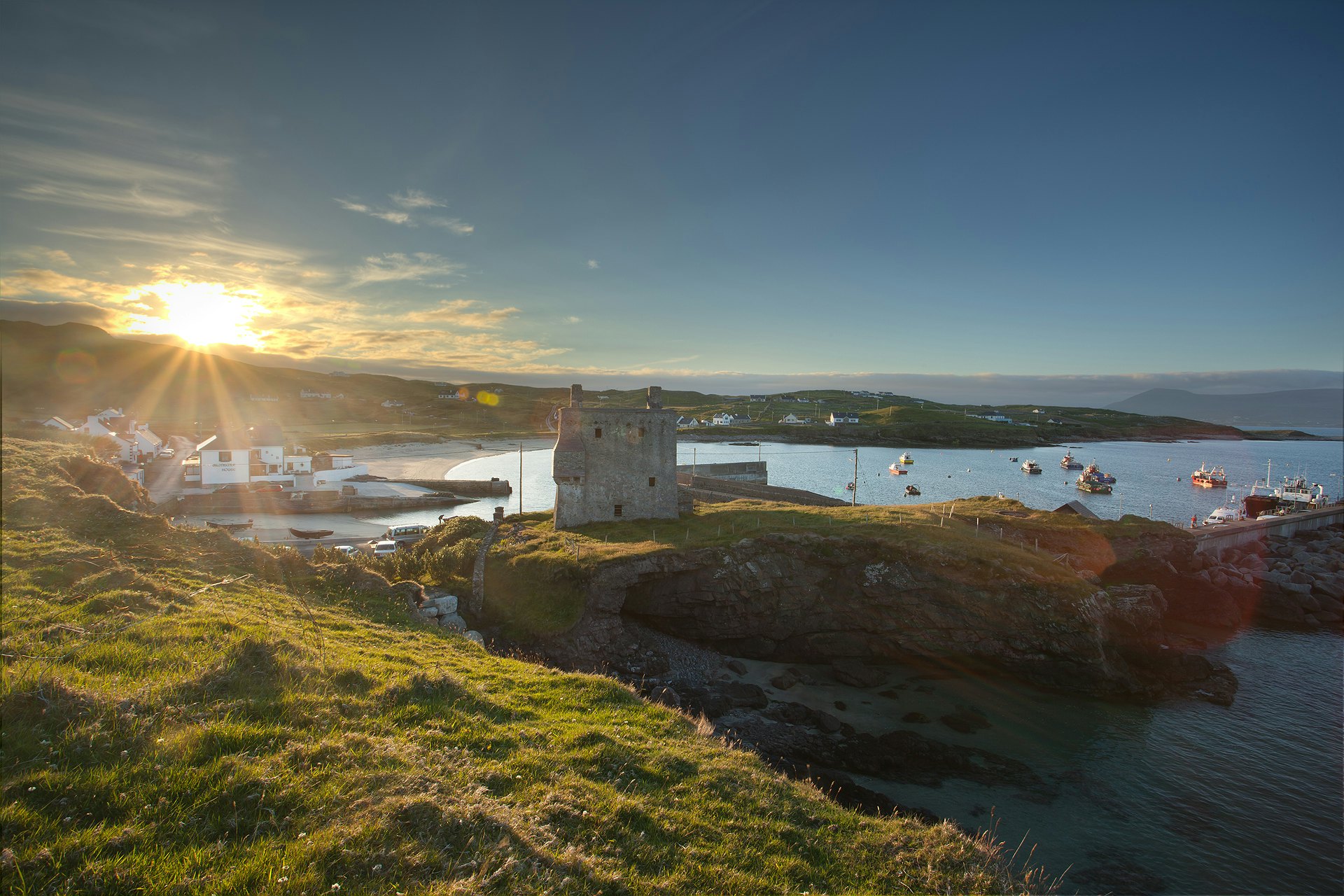
4. Clare Island, County Mayo
Best for pirate tales, mountain hiking and mindfulness
Mayo’s Clew Bay is said to have 365 islands – one for each day of the year – yet, in reality, it has 117, and Clare Island is the largest. With hills and mountains filled with historical sites and a Blue Flag beach, it’s a perfect island for outdoor activities.
Macalla Farm is a family-run retreat center that combines yoga, horses, food and mindfulness. Since it’s also a working farm, most of the food is produced on-site, with vegetarian meals available to guests throughout their stay. Crisscrossing the island are several walking and hiking routes that will knock the cobwebs out of your head. Two of the most popular are Clew Bay Archaeological Trail, which includes stop-offs at the 13–15th century abbey and a megalithic court tomb, and the Knocknaveena Loop, which takes you up and around Knocknaveen Mountain.
Things weren’t always so peaceful here. Clare Island is the ancestral home of Gráinne Mhaoil, the fearsome and legendary Pirate Queen Grace O’Malley. Notorious for wreaking havoc at sea for most of the 16th century, she used her castle here to control the waters of Clew Bay. (You can still visit Granuaile's Castle today.)
Nowadays there’s plenty to do at night, with the two pubs regularly putting on trad nights as entertainment, balancing the calm of the retreat with the storm of the session.
Get there: It takes approximately 25 minutes to get to Clare Island by ferry from Roonagh Pier, County Mayo. You can book ferry tickets from either Clare Island Ferry Co. or O’Malley Ferries.

5. Inishbofin, County Galway
Best for sustainable tourism, food festivals and historical walking tours
One of the most popular islands to visit in Ireland, Inishbofin is both steeped in history and a center for sustainable tourism. As the first Leave No Trace island in the country, a number of its beaches – including East End and Dumhach – have already received the Green Coast Award for environmental excellence thanks to their crystal-clear waters.
Walking tours are a huge draw for visitors here. On three official walking loops, you can take in sights like the Dún More Cliffs, one of the island’s two seal colonies, the 14th-century chapel of St Colman’s and panoramic views of Croagh Patrick, Inishturk and Clare Island. Alternatively, you can walk with the local historians and archaeologists of Cultúr na nOileáin Tours, who will tell you more about the island’s history, including its involvement with a certain Pirate Queen.
Gráinne Mhaol built another castle for herself here, aptly named Dún Gráinne, when her family took ownership of the island. Her Spanish pirate pal Alonzo Bosco built a castle opposite hers – and with these prime viewing spots, they prevented unwanted ships from entering the island by stretching an iron chain castle to castle, looting the cargo from the unfortunately ensnared vessels.
Inishbofin is also famous for its locally produced organic food. The annual food festival Bia Bó Finne, which draws hundreds of visitors each autumn, is a testament to this tradition.
Get there: To get to Inishbofin, you have to get a ferry from Cleggan Harbour, an hour and a half away from Galway City. The crossing time is roughly 30 minutes; you can book tickets for your trip online.

6. Inishturk, County Mayo
Best for world-class crab, lagoons and to feel like a local
Inishturk is the island less traveled. And with a population of just 54 people, you can easily end up feeling like a local rather than a tourist. The beating heart of Turk is its community center – which is also the island’s pub, shop and restaurant – where you can eat freshly caught lobster, pollock, mackerel and perhaps the best crab in the world.
But beyond the people, the hills are begging to be explored. The island’s ring road is exactly 5km (3 miles) long – perfect for runners. Further down the beaten track is the island’s GAA sports pitch, the most westerly one in Europe and – framed by rugged hills. Not far from this is another breathtaking view of Port Dún. This beautiful lagoon harbor is said to be the hiding spot of Gráinne Mhaol’s gold, and makes for a great spot for a swim.
Fishing is one of the island’s main draws and private angling trips can be arranged. But if you’d rather see the pros in action, Turk’s annual Seafest is a great excuse for a visit. The event blends music, wellness, eating and observing; expect to do beach yoga and learn the art of sean nós dancing, foraging or fileting a fish – all in one weekend.
Get there: Inishturk is 50 minutes by ferry from Roonagh Pier, which is not far from gorgeous Westport. Book tickets for your journey here.
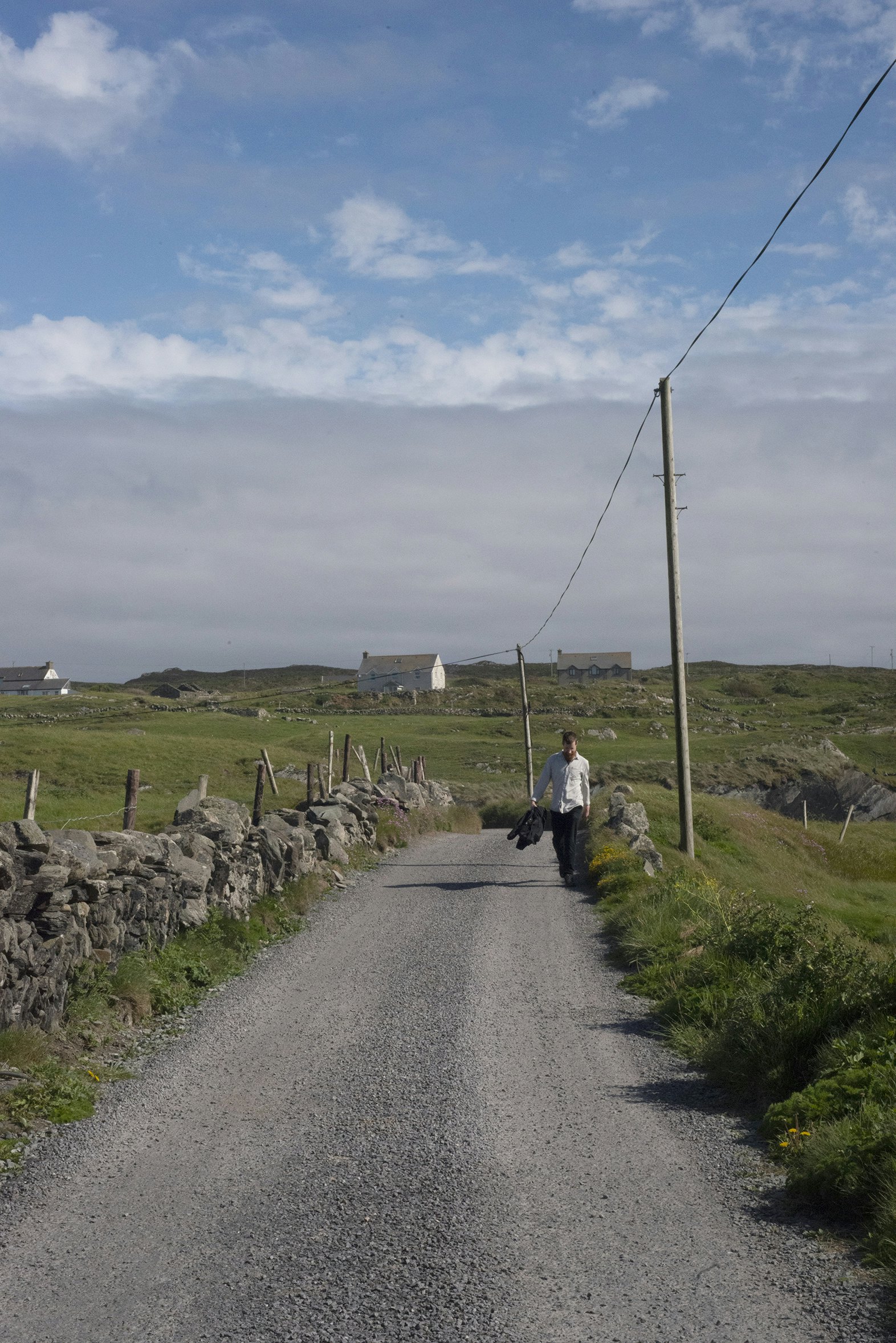
7. Sherkin Island, County Cork
Best for peace, quiet and an artistic vibe
The green hills, sandy beaches and jagged shorelines of Sherkin Island in West Cork contain a total population of 111 people. As the ferry pulls into the pier, you’ll see the ruins of Mainster Inis Arcain, the island’s 15th-century friary. And it’s all uphill from there. Literally.
Take the many twists on the main road to North Shore, with every turn showing a different side of the island, from leafy green canopies of the woodland trees to the dramatic coastline of Cow Strand Beach. With four walkways weaving throughout the island, each one catering to different walking abilities, you can take in the sights before settling into The Jolly Roger for a deserved evening pint. Home to artists, writers and musicians, the island crackles with creativity and locally made knitwear, silverwork, jewelry, wrought-iron pieces, candlesticks and decorative silk scarves are all available to buy.
Living at one of the most southerly points in Ireland, the people of Sherkin Island boast of their own warm microclimate. During the summer months, the island is a hub of activity with events like the Open Ear music festival, which specializes in contemporary art and alternative music. Even though things quiet down during winter, it remains a perfect retreat from the fast pace of life elsewhere.
Get there: A ferry from Baltimore, County Cork takes 10 minutes. Book your journey online.
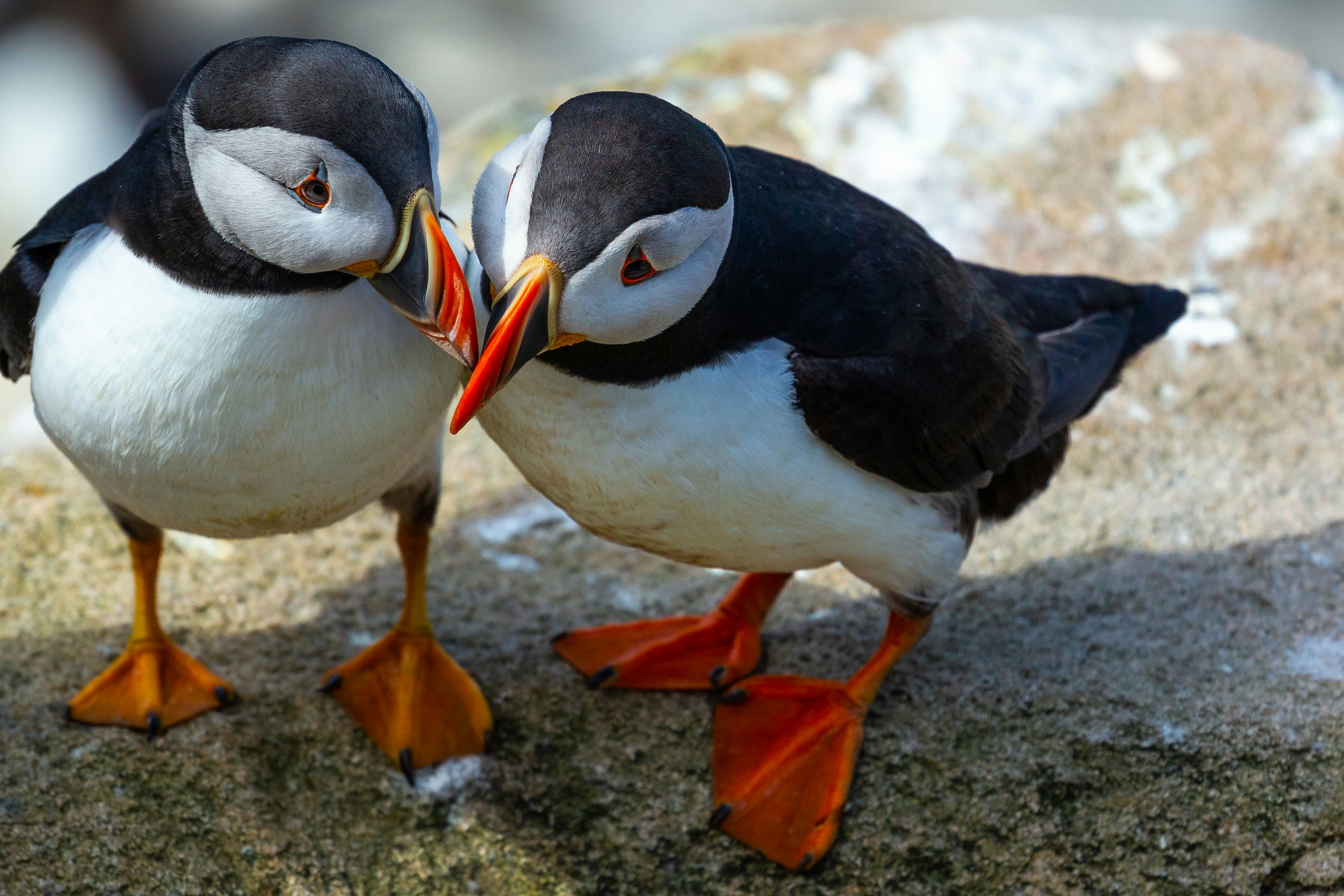
8. Saltee Islands, County Wexford
Best for a nature-filled day trip in a birdwatcher’s paradise
Just off the southern coast of County Wexford lie the two privately owned islands of Great Saltee and Little Saltee. Day visits to Great Saltee are permitted by the island’s residents, the Neale family, though Little Saltee is inaccessible due to the dangerous currents that surround it.
The Saltees are home to Ireland’s most famous bird sanctuary, with birds from all over the world stopping off on this busy migratory route. It’s also one of the few breeding locations for grey seals in eastern Ireland. When visiting the Saltees, you are asked to fully respect the island’s inhabitants, carrying out your own rubbish and avoiding the private home of the Neale family.
Perfect for picnics and rambling, Great Saltee has a rich history that will send your imagination into overdrive. The island is sometimes called the “Graveyard of a Thousand Ships,” and a number of vessels from both world wars sank off its coast. The island also has a regal past: Michael Neale, who bought the island in 1943, declared himself Prince Michael of the Saltees. “Coronated” in 1956, he built a throne, which you can still sit on, and erected an obelisk in his likeness. A mildly eccentric man, he also became a pilot – and it’s rumored that he once flew in 46 cats to deal with the island’s rat problem. Sadly, the cats are no longer there, which is probably a blessing for the birds.
Get there: The island is accessible by the Saltee Ferry from Kilmore Quay, Wexford Town. If the family is in residence, day-trippers are only allowed between 11:30am and 4:30pm; any visitors that land a boat outside of designated hours will be asked to leave. No overnight camping is permitted.

9. Lambay Island, County Dublin
Best for a private retreat with some unusual wildlife
Located just four kilometers off the east coast of Ireland in County Dublin, Lambay Island is privately owned, with a population of seven people, 100 red-necked wallabies, 200 fallow deer and thousands of seabirds. The island has been owned by the Barings family since 1904, and there’s an air of luxury due to the limited accommodation that’s available throughout the year.
The island has a total of 23 rooms, and only guests who have an existing connection to Lambay can stay in the renovated 15th-century castle or the White House. The rest of us can request to stay in O’Connell’s Cottage, which sits at the end of a row of 18th-century coastguard cottages and sleeps six people. If you fail to nab a bed, day tours are available, with options to go on walking and historical tours or simply to visit for lunch.
Throughout the year, various retreats are on offer including yoga, writing, foraging and cooking. The water from the island’s natural spring is not only used for drinking, washing, cooking and bathing: it’s also used to create the island’s own Lambay Whiskey.
Get there: The ferry takes 15–30 minutes from Malahide. You can book tickets from Skerries Sea Tours or find out about staying on the island here.
10. Rathlin Island, County Antrim
Best for secluded walks and rustic beauty
Rathlin Island enchants its visitors with its storied past, natural wonders and spirit of adventure. The only inhabited offshore island in Northern Ireland, Rathlin is home to about 150 people. Taking the Puffin Bus Service to the West Light Seabird Centre is a great way to observe some of the island’s other residents, including puffins and seals.
The village of Church Bay is the main hub for eating, drinking and accommodations if staying overnight on the island. From here, you can venture on foot or by bike to explore the wild, remote countryside. There are numerous trails to explore, ranging from gentle walks to challenging treks. The 6km (4 mile) Rathlin Trail showcases the dramatic landscapes of the island while offering sweeping views of the sea.
Dining options on the island are limited and some activities are cash only, so be sure to plan accordingly. However, Café Lazybird offers light, eclectic options and McCuaig’s Bar is a staple for classic pub fare and a good pint.
Get there: The passenger-only ferry service from Ballycastle makes the approximately 25-minute trip up to 10 times per day in the summer and five times per day in the winter. Booking ahead is advised.
11. Skellig Michael, County Kerry
Best for sci-fi fans
The jagged, 217m-high rock of Skellig Michael rises dramatically out of the sea 12km (7.5 miles) off the coast of County Kerry, topped with the remains of an improbable 1400-year-old early Christian monastery. The remote island famously featured as Luke Skywalker’s Jedi temple in two Star Wars movies, attracting a whole new audience to the Skelligs’ dramatic beauty.
Influenced by the Coptic Church (founded by St Anthony in the deserts of Egypt and Libya), the monks’ determined quest for ultimate solitude led them to this remote, windblown edge of Europe. Not much is known about the life of the monastery, but there are records of Viking raids in 812 and 823 CE. Although the site was expanded in the 12th century, the monks abandoned the rock soon afterward. In the 1820s, two lighthouses were built on the island, along with the road that runs around the base.
Key sites on the island include The Steps (three ancient staircases that lead to the top), the 6th-century monastery and The Hermitage, a small structure dating to the 9th century.
If you just want to see the islands up close and without having to clamber out of the boat, consider a ‘no landing’ cruise with operators such as Skellig Experience on Valentia Island.
Get there: Boat trips to the Skelligs usually run from mid-May to September (dates are announced each year by the Office of Public Works, which looks after the site), weather permitting. Boats depart from Portmagee, Ballinskelligs and Caherdaniel. The number of daily visitors is limited, with boats licensed to carry no more than 12 passengers each, so it’s wise to book well ahead.
12. Valentia Island, County Kerry
Best for history and heritage
Valentia Island is a beautiful and under-visited corner of Kerry with a rich and fascinating history. Its Latin-sounding name is actually an anglicized version of the Irish Béal Inse, meaning ‘the mouth of the island,’ a reference to the natural harbor entrance. The island is laced with narrow roads and lends itself to leisurely exploration by bike, though you could take in the main sights in a day by car.
A couple of sights explain Valentia’s role as the eastern terminus of the first transatlantic telegraph cable (the other end was at Heart’s Content in Newfoundland, Canada), established in 1866. The Valentia Transatlantic Cable Station in Knightstown (closed Mondays and Tuesdays and from November to March) chronicles the epic struggle that saw the birth of global telecommunications and is currently campaigning for Unesco World Heritage status. Also in Knightstown, Valentia Island Heritage Centre is an intriguing local museum with a treasure trove of artifacts that tell the tale of the island’s history more eloquently than any textbook.
Further flung attractions include Valentia Island Lighthouse (closed November to March), set in a 17th-century military fort at the northern tip of the island. You can visit the lightkeeper’s house and climb to the top of the lighthouse tower. Skellig Experience (closed from December to February) is just across the bridge from Portmagee at the southern end, with exhibits on local history, wildlife and the life of the Skellig Michael monks.
The local landowner has transformed the island’s highest point, Geokaun (266 meters/872 feet), into a network of easy walking trails and viewpoints, with a breathtaking outlook over the Fogher Cliffs. It’s possible to drive all the way to the top, so visitors with limited mobility don’t miss out on the views. At quieter times, the site is unstaffed, and entry is via an automatic barrier (payment with coins only).
Get there: You can get to Valentia Island via car ferry or road bridge from Portmagee.
13. Blasket Islands, County Kerry
Best for feeling like you’re on the edge of the world
The Blasket Islands (Na Blascaodaí) off the tip of the Dingle Peninsula are the most westerly part of Ireland and one of the westernmost points in Europe (after Iceland, the Azores and Rockall). All of the islands were lived on at one time or another; there is evidence of the largest, Great Blasket (An Blascaod Mór), being inhabited during the Iron Age and early Christian times. But no more – the last islanders abandoned their homes in 1953, moving to the mainland or North America after they and the government agreed that it was no longer viable to live in such harsh and isolated conditions.
The rich history and cultural life of the islands are celebrated in the Blasket Centre at Dunquin, a wonderful interpretative center housed in a striking modern building with a long white hall ending in a picture window looking directly at the islands. Great Blasket’s rich community of storytellers and musicians is profiled along with its literary visitors, such as playwright JM Synge, author of The Playboy of the Western World. The more prosaic practicalities of island life are covered by exhibits on boatbuilding and fishing.
Get there: There are two passenger services that operate in the summer: the Ferry from Dun Chaoin Pier and the Eco Ferry.








